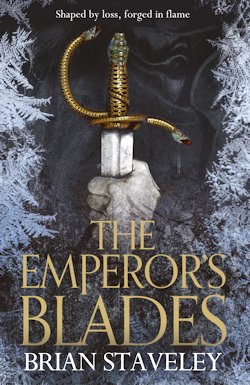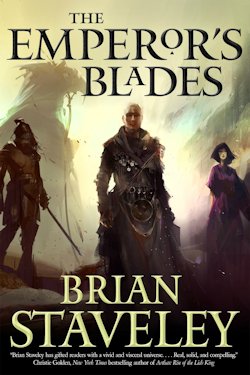Innovation is overrated.
Genre novels that do something new are released on a regular basis, and there’s no question that new things are nice. Neat in theory, at least. To wit, we should applaud the authors who attempt to put original ideas into practice. But just because something’s new doesn’t guarantee that it’s going to be great out of the gate. Innovation is initially as likely to result in the sort of dissonance that can spoil a story as it is the resonance its agents anticipate.
These days, the pressure applied to purveyors of fantasy fiction particularly to come up with something distinct and different—something to emblazon in all caps on the back of the jacket—is palpable. Listen too closely to picky critics and you’d be forgiven for thinking that a novel that does nothing notable in terms of the furtherance of the form—a novel that plays it safe, I suppose—is no novel at all. This is nonsense of the highest variety. There is, I think, plenty to be said for books that take hoary old tropes and put them to good use; books like The Emperor’s Blades by Brian Staveley, which I enjoyed an awful lot—excepting one big, blokish blunder—never mind its by-the-numbers nature.
It begins, as many fantasies have in the past, with the death of an Emperor:
Of course, Sanlitun hadn’t died of bad fucking luck. The Flea has said “treachery,” which meant that someone, probably a group of people, had conspired to betray and murder the Emperor. Which brought Valyn back to the Aedolian he had found in the ship’s hold only hours ago. It didn’t take a spymaster or a military genius to see that the threat against Valyn’s life was tied to the murder of the Emperor himself. […] Someone wanted to eliminated the Malkeenian line, and terrifyingly, they were managing it. Someone would be coming for Valyn, and not just him, but for Kaden, too. Even Adare might be in danger—although as a woman, she couldn’t sit the Unhewn Throne. That simple fact, so galling to her as a child, may have saved her life.
Here, then, are our central characters: the late Sanlitun’s sons, Kaden and Valyn, and his perpetually disappointed daughter Adare.
The sooner we talk about The Emperor’s Blades’ foremost failings, the sooner we can dig into the better bits of it, so I’m going to come right out as say that Staveley doesn’t do nearly enough with the women of his first fiction, and that which he does do is poor, to be sure. Though a suggestive synopsis of her part of the plot occupies one third of the blurb, and in retrospect she seems central to the overall arc of the otherwise ambitious narrative this book begins, Adare hardly features in the novel at all. In the five of its fifty chapters she is in—the others are divided down the middle between the brothers—all she does is push the plot along and—sigh—have some hanky-panky.
There are other instances of this, of women being a means to men’s ends rather than an end in themselves, and it gets worse before it gets better—as I expect it to in book two. Not to get ahead of ourselves, but when Valyn loses his initial love interest in upsetting, not to mention unsettling circumstances, he immediately starts checking out the breasts of other potential partners. Later, Kaden is presented with a sexy slave, and despite being aware of her nightmarish situation, he’s about to bed her anyway when, luckily, they’re interrupted.
The Emperor’s Blades’ single biggest issue is its treatment of its female figures. With only two exceptions to the best of my recollection, the purposes of the few women who have small parts to play in this performance are plain: they’re there to be saved by better men, or to have sex with said. The occasional female characters who aren’t forced into these obscenely convenient categories, namely Annick and Pyrre, are viewed, in the interim, with singular suspicion by our male narrators.

This is a real problem with the novel, obviously. There will be those who hate The Emperor’s Blades because of its manifest mistreatment of women, and at points I approached a similar position. But to review a book in full you’ve got to be able to take the long view, and when I finally forged on, I found plenty to recommend Staveley’s debut.
The Emperor’s heir, Kaden, is studying with a bunch of mountain-bound monks. He’s eight years into his training when the novel begins, however his monastery is so far from the capital that he doesn’t find out about his father’s unfortunate fate till the last act. “One day Kaden would return to Annur to claim his place on the Unhewn Throne, but while he lived at Ashk’lan, he was just another monk, expected to work hard and obey,” to better his mind in various ways.
The trials his mastery of the vaniate requires run the gamut from the cruel to the unusual, from being buried alive for a period of weeks to drawing the disemboweled bodies abandoned by the monster that’s been murdering its way round the mountains.
Half the world away, Valyn too has his trials, and these are still more brutal than those his big brother must overcome. But that’s the Kettral to a tee. The Empire’s last line of defence, they’re basically an elite legion of black-ops wing-walkers. The gospel according to Valyn’s sparring partner: “We’re Kettral. We kill people. If we have our way, we poison them, or we stab them in the back. Maybe we shoot them when they aren’t looking, and if at all possible, we do it at night. It might not be noble, but it’s necessary.”
Like Kaden, Valyn is approaching the end of his training, yet he wrestles regularly with the wrongness of what he’s been taught. Before he has the chance to put the Kettral code into practice, however, he’ll have to survive a increasingly suspicious series of accidents and a final test that could end in his death.
Neither of Sanlitun’s sons are inspiring protagonists at the start of this saga, entrenched as they are in plots that fantasy fans will be unfortunately familiar with. That said, Staveley develops both of the aforementioned threads well, suggesting depth and complexity with a deft touch and practiced, if not particularly pretty prose. I was taken in by his world as well, though we see only a little of it.
We see more of the awesome monsters that lurk in its deepest reaches:
Valyn risked a glance over his shoulder and glimpsed, in the distant recess of the cavern, in the fickle penumbra of the torch, a monster carved straight from the bloody dark of nightmare: scales, talons, teeth, all black as smoke steel, a dozen unnatural joins flexing in the shadow. And the size of it… it made the slarn he’d fought in the tunnel above look like puppies.
The Emperor’s Blades brings nothing new to the table, no—impressive as they are, even its monsters are in the final summation fairly customary—but what this debut does with the pieces already arrayed there is play with them in a creative way. It has significant issues, most notably its bewildering way with women, but Staveley’s failure to innovate is fine given that the riff he’s written does so much more with the fantasy tropes of yore than the vast majority of first novels.
If it ain’t broke, don’t fix it, and this decent debut doesn’t.
The Emperor’s Blades is available January 14th from Tor Books.
Read the first seven chapters here on Tor.com (also available as a free ebook download!)
Niall Alexander is an extra-curricular English teacher who reads and writes about all things weird and wonderful for The Speculative Scotsman, Strange Horizons, and Tor.com. He’s been known to tweet, twoo.










